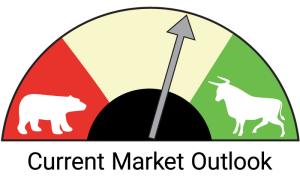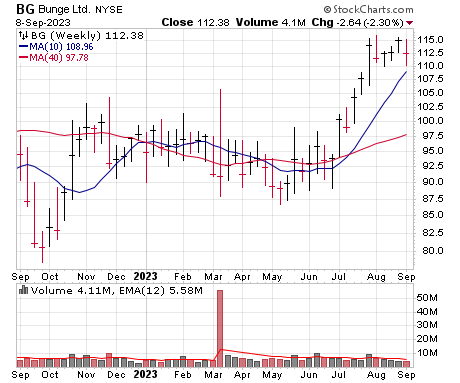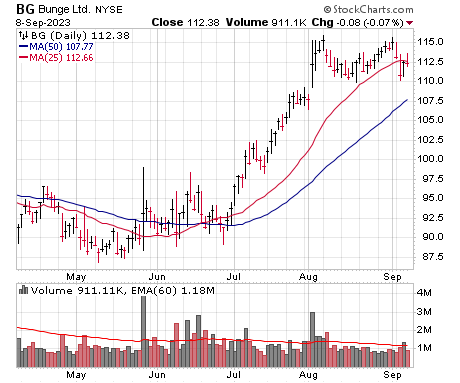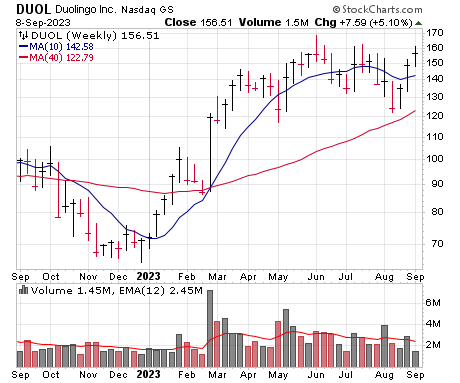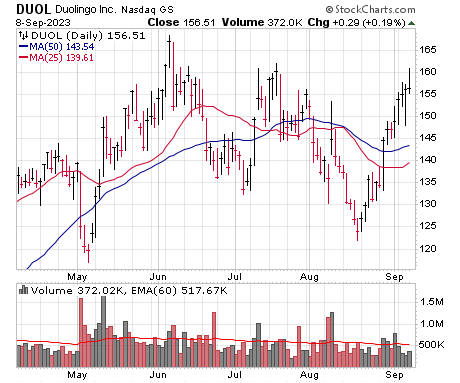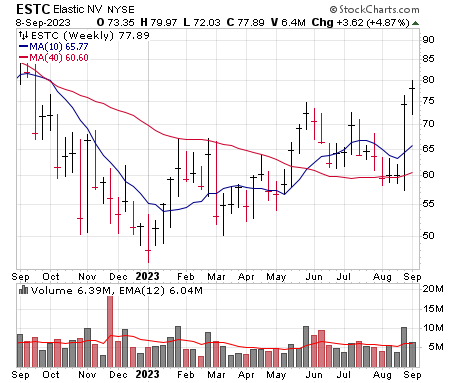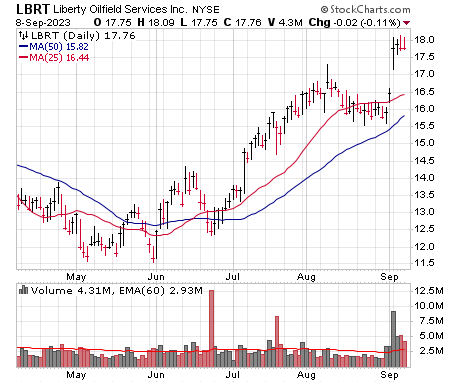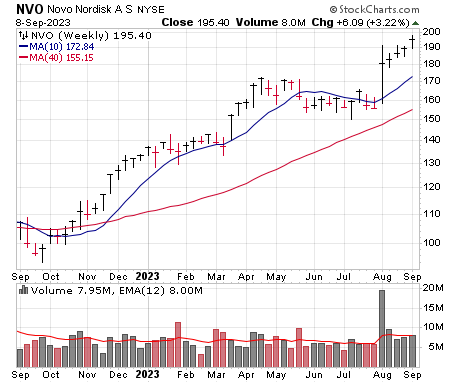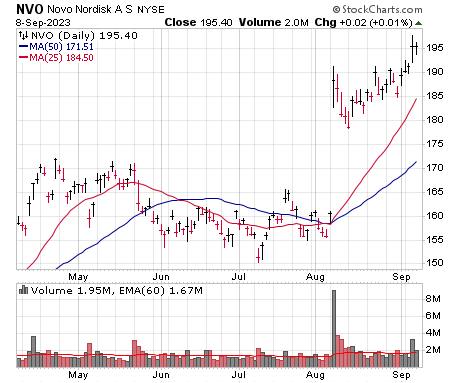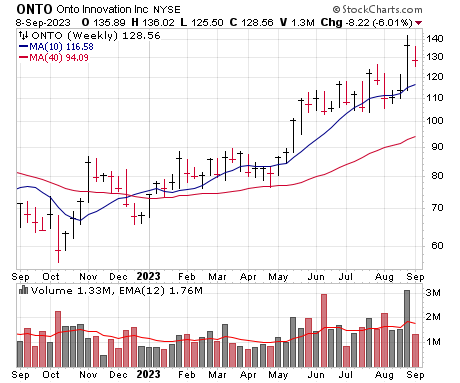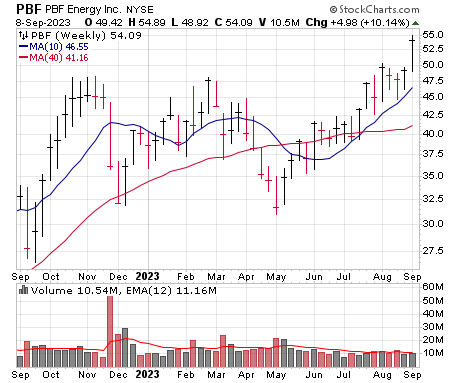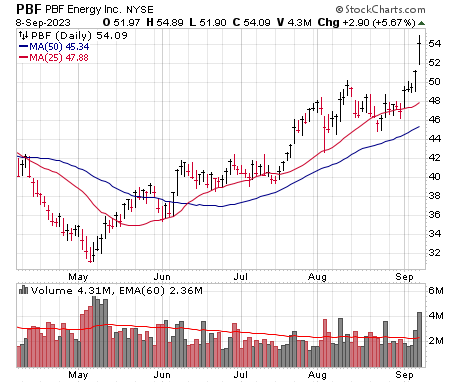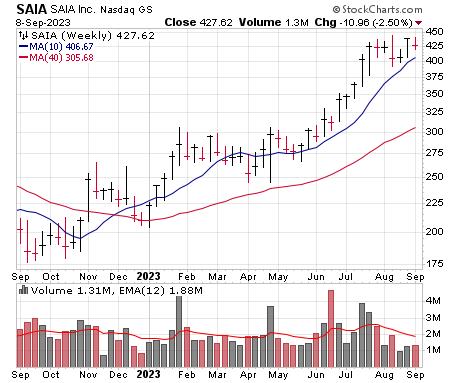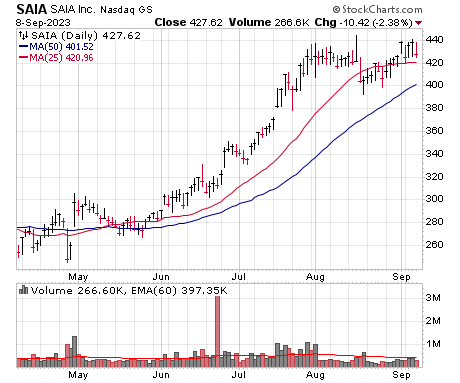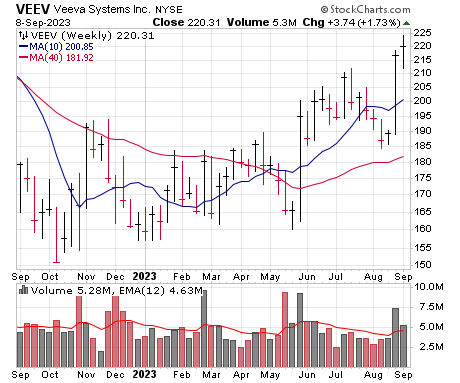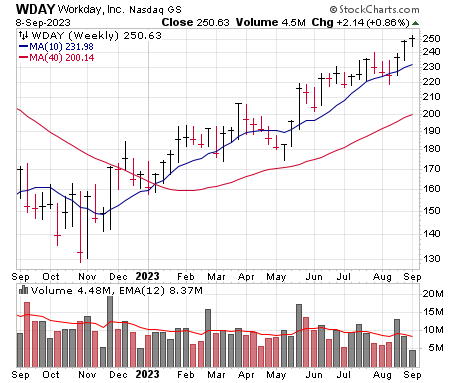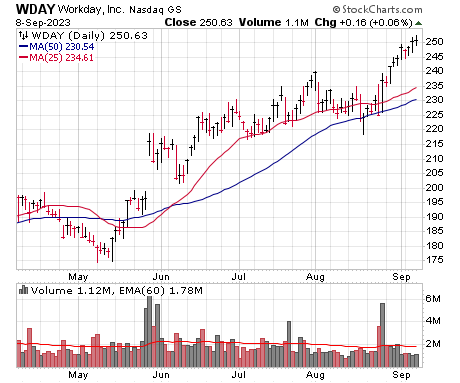Some Positives, but Correction Still in Force
Some of the positives that we saw in the latter half of August are still hanging around, not the least of which is a good amount of resilience from growth stocks that popped higher on earnings or otherwise saw good-volume buying; there seem to be more (not a ton, but more) names building out their launching pads for a future run. That said, the market as a whole doesn’t look ready, with last week bringing another round of selling in the broad market and the major indexes—the intermediate-term trend never could turn up, and while the selling pressures aren’t super-intense, the bottom line is few stocks are really moving up at this point. Long story short, there are some encouraging pieces of evidence, but more patience is likely needed as the market works its way through this correction phase. We’ll leave our Market Monitor at a level 6.
This week’s list is pretty well-rounded, with stocks from a variety of groups and of different sizes and profiles. Our Top Pick is Novo Nordisk (NVO), which looks like a clear winner in the drug space with two big sellers; we’re OK grabbing a few shares here or (preferably) on dips.
Price |
| Bunge (BG) |
| Duolingo (DUOL) |
| Elastic (ESTC) |
| Liberty Energy (LBRT) |
| Novo Nordisk (NVO) ★ Top Pick ★ |
| Onto Innovation (ONTO) |
| PBF Energy (PBF) |
| Saia (SAIA) |
| Veeva Systems (VEEV) |
| Workday (WDAY) |
Stock 1
Bunge (BG)
Price |
Why the Strength
Agribusiness giant Bunge is the world’s leader in oilseed processing and a major producer and supplier of specialty plant-based (mainly soybean) oils, fats and protein used in applications like animal feed, cooking oils and flours. The company is also a big player in sugarcane production, which involves the use of sugar in ethanol and alternative fuel production. Bunge’s exposure to soybeans and sugarcane are reasons for the stock’s strong performance, as both ag commodities have outperformed the broad commodity market this year. That said, the company is in the midst of diversifying in order to gain greater exposure to other crops and markets—it recently announced the acquisition of Canada’s largest grain handler, Viterra, which will provide Bunge access to the lucrative wheat, barley and cotton markets across North America, Europe and Australia, beyond Bunge’s main market of South America. (The deal is expected to close in mid-2024 and will generate an estimated $250 million in annual earnings within three years of completion; Bunge also plans to repurchase $2 billion of its own stock related to the deal.) In Q2, Bunge’s revenue of $15 billion was 16% lower from a year ago, but earnings of $3.72 a share increased 25% and beat estimates by a whopping $1.03. The mostly sanguine results were driven by continued strength in the firm’s Refined and Specialty oils segment, plus strong biofuel and food service demand in North America. As it stands now, earnings could dip a bit more (but remain elevated), but the Viterra buyout will likely boost estimates if/when it goes through.
Technical Analysis
BG spent the first half of this year in a minor funk, sliding from a January high of slightly above 100 to a low around 90 by May. But the decline was only a small part of a much bigger basing pattern that began last year, and it paved the way for the stock’s change of character in early July: BG ran up more than 25 points over the next five weeks before resting for the past few weeks as the 50-day line (now above 108) catches up. We’re OK with a nibble here and a tight stop.
| Market Cap | $17.0B | EPS $ Annual (Dec) | ||
| Forward P/E | 9 | FY 2021 | 12.93 | |
| Current P/E | 8 | FY 2022 | 13.93 | |
| Annual Revenue | $63.8B | FY 2023e | 12.39 | |
| Profit Margin | 5.2% | FY 2024e | 11.87 | |
| Qtrly Rev | Qtrly Rev Growth | Qtrly EPS | Qtrly EPS Growth | |
| ($B) | (vs. yr-ago-qtr) | ($) | (vs. yr-ago-qtr) | |
| Latest qtr | 15.0 | -16% | 3.72 | 25% |
| One qtr ago | 15.3 | -3% | 3.26 | -23% |
| Two qtrs ago | 16.7 | 0% | 3.24 | -7% |
| Three qtrs ago | 16.8 | 19% | 3.45 | -7% |
Weekly Chart | Daily Chart |
Stock 2
Duolingo (DUOL)
Price |
Why the Strength
Duolingo is a great non-tech growth story, with a dominant position in language learning—and a platform that could easily branch out to more learning channels down the road. The firm has the top-grossing education app out there, with more people learning certain languages (like Irish and Hawaiian) than there are native speakers of those languages! There are two big company advantages here: First, the app is actually game-like and fun, with goals and rewards that continually attract current and new users; at the end of June, the firm had 74.1 monthly active users (up 50% from a year ago) and 21.4 daily active users (up 62%). Because of the firm’s freemium model, many use it for free (though they see ads at the end of every lesson; ad revenue is about 10% of the total), but Duolingo is increasing its monetization, with 7.9% of monthly users now paying (up from 7.2% a year ago), resulting in a 59% gain in paid subs (subscriptions make up three-quarters of revenue). The second advantage is the firm’s dataset—in management’s words, the hundreds of millions of exercises completed on its app/platform create the largest learning data hoard out there, which it uses (with the help of AI) to constantly tweak and improve the program. Whatever Duolingo is doing, it’s working: Currency-neutral revenues rose 46% in Q1, while earnings, EBITDA and free cash flow (which totaled about $1.50 per share in the first half of the year, miles above earnings) were all solidly in the black. Growth is forecast to slow some, but the firm has a history of easily topping estimates, and the big-picture potential here for languages alone (not to mention other avenues) remains big. We like it.
Technical Analysis
DUOL’s coming out party was in March, when the stock exploded higher despite the weak market, but while it rallied further, it reached a peak in May, just as many growth stocks were taking off. The correction from there came in two waves and took the stock down by 28% over 14 weeks and nearly tagged the 40-week line—but now the buyers are stepping up, with three straight gains (one on solid volume) as DUOL approaches resistance near 160. It’s a good-looking launching pad, but we’ll set our buy range down a bit as the stock is notoriously volatile.
| Market Cap | $6.50B | EPS $ Annual (Dec) | ||
| Forward P/E | N/A | FY 2021 | -1.63 | |
| Current P/E | N/A | FY 2022 | -1.51 | |
| Annual Revenue | $443M | FY 2023e | -0.21 | |
| Profit Margin | N/A | FY 2024e | 0.05 | |
| Qtrly Rev | Qtrly Rev Growth | Qtrly EPS | Qtrly EPS Growth | |
| ($M) | (vs. yr-ago-qtr) | ($) | (vs. yr-ago-qtr) | |
| Latest qtr | 127 | 44% | 0.08 | N/A |
| One qtr ago | 116 | 42% | -0.06 | N/A |
| Two qtrs ago | 104 | 42% | -0.35 | N/A |
| Three qtrs ago | 96.1 | 51% | -0.46 | N/A |
Weekly Chart | Daily Chart |
Stock 3
Elastic (ESTC)
Price |
Why the Strength
Elastic specializes in data analytics, primarily search functions and security analysis. Its software provides real-time search capabilities across many varied firms of data, including text, numerical, geospatial and unstructured data, using machine learning to advance its efforts. Its Elasticsearch product provides real-time ability to draw out data and analyze information, both on cloud and on-premise systems at customer facilities (the latter is still about 59% of business). That capability also provides the basis for a robust security monitoring system that is increasingly being utilized as well. Elastic’s apps sit on top of other systems used by clients, including AWS, Microsoft and other large database and cloud providers. The company makes revenue primarily on a consumption basis, so the more searches made through its apps by its tens of thousands of users, the more money gets spent (about 1,200 customers have annual contracts of $100,000 of more). The pricing structure means it’s benefiting greatly from the continued explosion of data: In its first quarter, ended July 31 and reported last week, Elastic saw revenue rise 17% to $294 million, with its cloud business growing faster, at 24%, to comprise 41% of sales. The emergence of generative AI promises to be a boon to the business as well, with Elastic’s ability to handle many unique and sophisticated searches across data types lending itself well to natural language search queries. Growth isn’t out of this world but looks solid: Management sees revenue for the September quarter rising about 15%, to $304 million, while the bottom line is seen booming by Wall Street through 2024.
Technical Analysis
ESTC collapsed from 190 at its peak to a low of 46 this January, and unlike many other tech plays, it never really kicked into gear in the spring, with a rally to 75 in early June leading to a fairly persistent slip back to 60 last month. But the stock tightened up near the 40-week line and then the latest quarterly report saw a big gap and follow-through to multi-month highs, and the recent modest dip is a good sign that owners aren’t eager to let go of their shares. ESTC likely won’t be up and away with the market still iffy, but a bit more weakness could be bought.
| Market Cap | $7.73B | EPS $ Annual (Apr) | ||
| Forward P/E | 72 | FY 2022 | -0.33 | |
| Current P/E | 121 | FY 2023 | 0.25 | |
| Annual Revenue | $1.11B | FY 2024e | 1.09 | |
| Profit Margin | 10.2% | FY 2025e | 1.51 | |
| Qtrly Rev | Qtrly Rev Growth | Qtrly EPS | Qtrly EPS Growth | |
| ($M) | (vs. yr-ago-qtr) | ($) | (vs. yr-ago-qtr) | |
| Latest qtr | 294 | 17% | 0.25 | N/A |
| One qtr ago | 280 | 17% | 0.22 | N/A |
| Two qtrs ago | 275 | 23% | 0.17 | N/A |
| Three qtrs ago | 264 | 28% | 0.01 | N/A |
Weekly Chart | Daily Chart |
Stock 4
Liberty Energy (LBRT)
Price |
Why the Strength
Liberty Energy isn’t a well-known name in the oilfield services segment, having come public just five years ago, but it should be—it’s the 4th largest player in the market at this point and, according to one report, is the top premium provider of well completion services, operating in all the key onshore U.S. basins and offering a broader array of offerings (it’s added proppant handling, sand mines, gas delivery and lots of big data technology to its traditional well completion and frac services) than many; its digiTechnologies suite of frac products looks like a big draw down the road, being the leading natural gas-fueled completions solutions, leading to higher margins, less emissions and more. The top brass has also long emphasized running a tight ship (net debt here is nearly zero, margins are excellent for the industry) and returning money to shareholders (usually via buybacks, as the share count is off 9% from a year ago, though there’s also a 1.1% yielding dividend). Obviously, the overall environment for drilling is the main factor here, but as long as the sector remains in decent shape, Liberty should thrive: Q2 results (sales up 27%, earnings and EBITDA both up 58%) were terrific, and free cash flow for the trailing 12 months totaled around $4 per share, well ahead of earnings, which helps funds both small Q&A and the buybacks. There’s expected to be some retrenchment in the bottom line after the boom of the past couple of years, but (a) the stock’s likely already discounted that, trading at less than 7x 2024 estimates, and (b) that figure is likely conservative given the share buyback program and the recent pickup in energy prices. Liberty looks like a solid oil services play.
Technical Analysis
LBRT’s earnings have gone wild the past couple of years, but the stock is still stuck in a giant range—though it’s showing signs that it wants to get going. After falling with the sector in March on banking and economic fears, the stock found support many times in the 11 to 12 area before getting going in early July. Then, after a race up to 17, the ensuing retreat was tame and found support at the 10-week line, with LBRT bounding to higher highs this month. We wouldn’t argue with a small buy here, but we prefer to get in on dips of a few dimes.
| Market Cap | $3.06B | EPS $ Annual (Dec) | ||
| Forward P/E | 9 | FY 2021 | -1.03 | |
| Current P/E | 5 | FY 2022 | 2.11 | |
| Annual Revenue | $4.88B | FY 2023e | 3.09 | |
| Profit Margin | 16.7% | FY 2024e | 2.74 | |
| Qtrly Rev | Qtrly Rev Growth | Qtrly EPS | Qtrly EPS Growth | |
| ($B) | (vs. yr-ago-qtr) | ($) | (vs. yr-ago-qtr) | |
| Latest qtr | 1.20 | 27% | 0.87 | 58% |
| One qtr ago | 1.26 | 59% | 0.90 | N/A |
| Two qtrs ago | 1.23 | 79% | 0.82 | N/A |
| Three qtrs ago | 1.19 | 82% | 0.78 | N/A |
Weekly Chart | Daily Chart |
Stock 5
Novo Nordisk (NVO) ★ Top Pick ★
Price |
Why the Strength
Diabetes treatments turned weight-loss drugs Wegovy and Ozempic are both owned by Novo Nordisk, meaning the company is booming on the potential for each. Growth in the treatments is eye-popping, up more than 40% this year alone. Demand in the U.S., where four of 10 adults are considered obese, is so strong that doctors offices are prescribing it like mad and management expects it to take years to fulfill projected American demand. It’s a market that should power Novo to better results in the foreseeable future. In the latest quarter, ended June, management said the diabetes and obesity drugs accounted for all the company’s growth, with about 71% of that expansion coming from the U.S. Sales were up 30% in local currency terms, to 54.3 billion Danish krone ($7.96 billion) with the equivalent of $1.26 earnings per share, a jump of 53%. It’s the strongest growth in the history of Novo Nordisk. The current quarter looks to be even better, with management guiding to sales of 56 billion DKK ($8.1 billion) and $1.28 EPS. Margins should continue to expand thanks to the drugs’ pricing power, even as the firm is still funding heavy investment in its supply chain to meet demand. R&D spending is also focused on oral versions of the drugs (they are primarily injections today); this quarter, Novo Nordisk is expected to submit 25- and 50-mg pill versions for diabetes and/or weight loss purposes to the FDA and in Q4 to European authorities. There could be more to come beyond weight control: semaglutide, the molecule Wegovy and Ozempic are based on, shows hints of benefiting mental health and reducing heart failure. Not everything is perfect: Novo’s insulin offerings Novolog and Fiasp probably will see biosimilar generics come to market in the next couple of years – but the main story here is excellent.
Technical Analysis
NVO rallied nicely to 172 in April but then built a tight, flat base for the next few months before shares gapped up to new highs in August. We wrote it up back then but missed our entry point—shares didn’t budge much despite the weak market and have kited to new highs in recent weeks even as most stocks have struggled. We’re OK with a small buy here, though 200 could provide some round-number resistance, so ideally you can get in on minor weakness.
| Market Cap | $440B | EPS $ Annual (Dec) | ||
| Forward P/E | 38 | FY 2021 | 3.17 | |
| Current P/E | 46 | FY 2022 | 3.52 | |
| Annual Revenue | $26.5B | FY 2023e | 5.21 | |
| Profit Margin | 46.4% | FY 2024e | 6.18 | |
| Qtrly Rev | Qtrly Rev Growth | Qtrly EPS | Qtrly EPS Growth | |
| ($B) | (vs. yr-ago-qtr) | ($) | (vs. yr-ago-qtr) | |
| Latest qtr | 7.77 | 24% | 1.26 | 53% |
| One qtr ago | 6.92 | 18% | 1.28 | 38% |
| Two qtrs ago | 6.01 | 8% | 0.87 | 19% |
| Three qtrs ago | 5.82 | 10% | 0.84 | 2% |
Weekly Chart | Daily Chart |
Stock 6
Onto Innovation (ONTO)
Price |
Why the Strength
Onto Innovation is a smaller player in the chip equipment field, specializing in metrology and inspection equipment, both of which are essentially used to boost chip manufacturing yield, something that’s always been necessary but is becoming even more vital as chips become more powerful, have a greater number of circuits and the like. Even the leading players in the market (KLA Corp. is the top dog) have been shrinking of late due to industry pressures, and Onto hasn’t been an exception; Wall Street sees the bottom line down by a third this year. But the stock is strong for a couple of reasons. First, most expect good times to return later this year, and Onto’s own sour Q2 quarterly results were affected by one customer delaying three machines into Q3. Second, though, and more important, is optimism surrounding Onto’s offerings in the growing AI GPU field—it’s still a small piece of the pie (hard to tell, but seems like 5% to 10% of revenue), but the firm’s Dragonfly series of equipment is well suited for inspection of high-performance AI chips, production of which is set to boom; already in Q2 there was a demand surge (20% to 35% sequential growth), with the best yet to come—in the conference call, the top brass said it expected $90 million of revenue from these products in the next three quarters, but since then, it announced $100 million of Dragonfly orders, with deliveries now extending into the second half of 2024. Partly because of that, Wall Street sees the bottom line rebounding 27% next year, but really Onto will be news-driven—it’s obviously a down-the-food-chain story, but if the Dragonfly system is something special and orders continue to ramp, the stock should follow.
Technical Analysis
ONTO peaked in late 2021 with all chip stocks had the typical bearish downs in 2022, followed by some rebound late last year and some tightness early this year. The breakout came in May, though after two good weeks, shares basically chopped around in a wide range with support slightly below the 50-day line on its periodic dips. However, late August brought three days of big volume buying after its order announcement, and the pullback since has been normal given the market’s continued wobbles. It’s a wild child, but we’re OK with a small position on this retreat with a stop in the 115 area.
| Market Cap | $6.31B | EPS $ Annual (Dec) | ||
| Forward P/E | 35 | FY 2021 | 3.86 | |
| Current P/E | 28 | FY 2022 | 5.52 | |
| Annual Revenue | $897M | FY 2023e | 3.67 | |
| Profit Margin | 22.9% | FY 2024e | 4.65 | |
| Qtrly Rev | Qtrly Rev Growth | Qtrly EPS | Qtrly EPS Growth | |
| ($M) | (vs. yr-ago-qtr) | ($) | (vs. yr-ago-qtr) | |
| Latest qtr | 191 | -26% | 0.79 | -38% |
| One qtr ago | 199 | -17% | 0.92 | -30% |
| Two qtrs ago | 253 | 12% | 1.57 | 28% |
| Three qtrs ago | 254 | 27% | 1.35 | 38% |
Weekly Chart | Daily Chart |
Stock 7
PBF Energy (PBF)
Price |
Why the Strength
With crude oil prices on the rise, it’s no surprise the energy sector continues to produce a bunch of of strong performers. One of the more attractive ones right now is PBF Energy, which is one of the largest independent petroleum refiners, and then there’s the company’s Logistics segment, which includes owning, leasing and the acquisition of terminals, pipelines and storage facilities. Earlier this year, PBF entered a 50/50 joint venture with global integrated energy giant ENI for a biorefinery in Louisiana—the St. Bernard Renewables (SRB) biorefinery—which will produce hydrotreated vegetable oil (renewable diesel) with a production capacity of over 300 million gallons per year. SRB started commercial production in June and sold its first products in July, and ENI has committed to providing capital contributions of $846 million to PBF for the project, paid in Q2 and Q3 of this year. In the latest quarter (ended June 30), PBF posted revenue of $9.2 billion that was 35% lower year-on-year and earnings of $2.29 a share that beat estimates by a dime, led by strength in the Refining segment. Thanks in part to SRB, the firm said it was on pace for its second-best financial year ever and that for the first time in its history, it now owns and controls all its inventory, which management called a “milestone event.” Looking ahead, PBF expects a “tight” balance between global refining capacity and refined product demand. Earnings are still backtracking after a ridiculous upmove in 2022, but they’re fading less than expected, which means the stock looks cheap even when looking at 2024 numbers. A 1.5% dividend yield ties the bow on this attractive package.
Technical Analysis
PBF hit a multi-year high at 48 last November and then spent the next eight months bobbing and weaving in a loose, lateral trading range. Shares started tightening up in June and burst out of the gate in July as crude oil prices took off. Last week’s breakout came on solid volume and was preceded by a reasonable rest just short of the prior high near 50. We’ll set our buy range down a bit, thinking a normal exhale is likely.
| Market Cap | $6.70B | EPS $ Annual (Dec) | ||
| Forward P/E | 5 | FY 2021 | -2.42 | |
| Current P/E | 3 | FY 2022 | 23.36 | |
| Annual Revenue | $42.1B | FY 2023e | 10.87 | |
| Profit Margin | 4.3% | FY 2024e | 6.78 | |
| Qtrly Rev | Qtrly Rev Growth | Qtrly EPS | Qtrly EPS Growth | |
| ($B) | (vs. yr-ago-qtr) | ($) | (vs. yr-ago-qtr) | |
| Latest qtr | 9.16 | -35% | 2.29 | -78% |
| One qtr ago | 9.30 | 2% | 2.76 | 689% |
| Two qtrs ago | 10.8 | 32% | 4.41 | 245% |
| Three qtrs ago | 12.8 | 78% | 7.96 | 999% |
Weekly Chart | Daily Chart |
Stock 8
Saia (SAIA)
Price |
Why the Strength
The recent collapse of transportation giant Yellow Corp. has opened up a sizable opportunity for trucking companies that specialize in less-than-truckload (LTL) freight shipments (typically 150 to 15,000 pounds). Saia is a leading LTL shipper, operating nearly 200 owned and leased terminals across North America and Puerto Rico, and it’s already seeing the benefits of the decreased competition. Last week, Saia provided updated LTL shipment and tonnage data for July and August that showed year-on-year LTL shipments and tonnage per workday increases of 6% and 3%, respectively, for July. For August, those metrics showed eye-opening improvements of 14% and 7%, respectively, as many of Yellow’s former customers moved their business to Saia. The latest surge in tonnage was welcome news after a less-than-stellar Q2 in which revenue of $695 million declined 7%, while LTL shipments per workday dropped 4%. Per-share earnings of $3.42 were also lower year-on-year but beat expectations by 14 cents. The company blamed the lower Q2 results on a softer economic environment than the year-ago period but said its performance was still solid thanks to lower fuel costs and strong core execution that helped moderate the tonnage declines. Of course, those results don’t take into account the recent improvement to the LTL market landscape post-Yellow, and the firm has opened five new terminals this year, which it says will make it easier to attract more future LTL business. Bottom line, the future looks a lot better than the past: Analysts anticipate further improvement to Saia’s tonnage volumes in the wake of Yellow’s closure and see earnings resuming growth in Q4, and we’re guessing 2024’s estimates will prove conservative.
Technical Analysis
SAIA topped at 360 in late 2021 and was cut nearly in half by the time the final low was reached last June. Then came a long, multi-month bottoming process that finally bore fruit early this year when the bulls returned and sent SAIA galloping higher about one year after its ultimate low. Shares broke above the old high in July and have spent the last several weeks consolidating normally as the market wobbles. If you’re game, you can nibble here or on dips.
| Market Cap | $11.4B | EPS $ Annual (Dec) | ||
| Forward P/E | 34 | FY 2021 | 9.36 | |
| Current P/E | 35 | FY 2022 | 13.40 | |
| Annual Revenue | $2.74B | FY 2023e | 12.75 | |
| Profit Margin | 17.5% | FY 2024e | 15.47 | |
| Qtrly Rev | Qtrly Rev Growth | Qtrly EPS | Qtrly EPS Growth | |
| ($M) | (vs. yr-ago-qtr) | ($) | (vs. yr-ago-qtr) | |
| Latest qtr | 695 | -7% | 3.42 | -17% |
| One qtr ago | 661 | 0% | 2.85 | -4% |
| Two qtrs ago | 656 | 6% | 2.65 | -4% |
| Three qtrs ago | 730 | 18% | 3.67 | 28% |
Weekly Chart | Daily Chart |
Stock 9
Veeva Systems (VEEV)
Price |
Why the Strength
Success in today’s drug and medical device markets typically depends on having a strong platform for managing data relating to every step in the product development process. This is where cloud software specialist Veeva comes into play. The company provides a suite of products, including customer relationship management (CRM), data storage and analytics that help pharmaceutical companies manage clinical trial data, maintain regulatory compliance and improve quality control. Veeva has no major competitors within its niche and is widely utilized in the life sciences sector, which has led to impressive and steady growth for many years—however, last year’s sharp drop in biotech sector spending was a speed bump for Veeva and resulted in lower growth of 16% for fiscal 2023 (ended January 31), plus additional deceleration in fiscal Q1 2024, causing many analysts to worry about the year-ahead outlook. But the company put those fears to rest in Q2 when it announced that sales have rebounded along with operating margins. Indeed, revenue of $590 million increased 10% from a year ago, led by sales jumps of 10% in subscription services and 13% in professional services, while per-share earnings of $1.21 topped estimates by eight cents. The company said progress was seen across the board, but was “particularly significant” in the CRM and clinical software segments. Veeva also just announced the first customer win for its next-generation Vault CRM product, which is scheduled for launch next April. The days of 30%-plus growth are probably over, but management expects sales and earnings growth to gradually accelerate from here, and Wall Street seems to agree.
Technical Analysis
VEEV fell from 340 to 150 during the bear and then had a prolonged bottoming process, retesting the 150 to 160 area numerous times in the next year. A bullish earnings reaction in June changed the landscape, and after a dip with the market into August, VEEV’s Q2-induced pop two weeks ago sent shares to 12-month price and relative performance highs. With the path of least resistance up, we’re OK buying some here with a stop near the 50-day line.
| Market Cap | $35.0B | EPS $ Annual (Jan) | ||
| Forward P/E | 47 | FY 2022 | 3.73 | |
| Current P/E | 50 | FY 2023 | 4.28 | |
| Annual Revenue | $2.23B | FY 2024e | 4.67 | |
| Profit Margin | 42.5% | FY 2025e | 5.56 | |
| Qtrly Rev | Qtrly Rev Growth | Qtrly EPS | Qtrly EPS Growth | |
| ($M) | (vs. yr-ago-qtr) | ($) | (vs. yr-ago-qtr) | |
| Latest qtr | 590 | 10% | 1.21 | 17% |
| One qtr ago | 526 | 4% | 0.91 | -8% |
| Two qtrs ago | 563 | 16% | 1.15 | 28% |
| Three qtrs ago | 552 | 16% | 1.13 | 16% |
Weekly Chart | Daily Chart |
Stock 10
Workday (WDAY)
Price |
Why the Strength
Workday is a giant in the cloud software space, offering products for finance, human capital management (HCM), planning and spend management, serving more than 10,000 organizations globally and covering over half the companies in the Fortune 500. It’s not the young upstart it once was, but these days institutional investors are looking for reliability, and this company has it: In its fiscal second quarter of 2024 (ended July 31), revenue increased 16% year-on-year to $1.8 billion and EPS of $1.43 beat expectations by 14% (reasons for the stock’s strength). The sterling results were led by a 19% increase in subscription services revenue, a 23% rise in 24-month subscription revenue backlog and a 33% bump in total subscription revenue backlog to nearly $18 billion (which speaks to the reliability factor). The company said the metrics show it’s “incredibly well positioned” going into the second half of the fiscal year, driven by a growing customer base, continued global expansion, industry growth and partner ecosystem momentum. (What’s more, the bullish metrics put Workday on a major Wall Street bank’s “very important positions” list of top stocks owned by hedge and mutual funds.) Looking ahead, management touted Workday’s progress on the artificial intelligence front, including several AI initiatives it plans to unveil at its Workday Rising company event later this month, adding that more than 3,000 customers are sharing their data with Workday’s machine learning models and that it expects this to open up “new market opportunities with direct monetization that are wholly based on AI technologies.” Workday raised fiscal 2024 subscription revenue guidance to around $6.6 billion, up 18% if realized, and expects Q3 subscription sales to grow 17%. Further out, the company sees a “significant runway” for expansion in its biggest market, the U.S., and said expanding its footprint globally is a top priority. Expect sales, earnings and cash flow to continue to crank ahead.
Technical Analysis
WDAY hit a major low last November at 130 and promptly embarked on a turnaround that has seen shares advance in a step-function manner over the last several months. Aside from a pronounced drop in April-May that found support above the 40-week line, pullbacks have been relatively shallow and short-lived with the 50-day line providing most of the support. A reasonable exhale from round-number resistance of 250 would be tempting.
| Market Cap | $66.0B | EPS $ Annual (Dec) | ||
| Forward P/E | 45 | FY 2022 | 3.99 | |
| Current P/E | 53 | FY 2023 | 3.64 | |
| Annual Revenue | $6.72B | FY 2024e | 5.59 | |
| Profit Margin | 26.1% | FY 2025e | 6.59 | |
| Qtrly Rev | Qtrly Rev Growth | Qtrly EPS | Qtrly EPS Growth | |
| ($B) | (vs. yr-ago-qtr) | ($) | (vs. yr-ago-qtr) | |
| Latest qtr | 1.79 | 16% | 1.43 | 72% |
| One qtr ago | 1.68 | 17% | 1.31 | 58% |
| Two qtrs ago | 1.65 | 20% | 0.99 | 27% |
| Three qtrs ago | 1.60 | 20% | 0.99 | -10% |
Weekly Chart | Daily Chart |
Previously Recommended Stocks
| Date | Stock | Symbol | Top Pick | Original Buy Range | 9/11/23 |
| HOLD | |||||
| 8/14/23 | 510-525 | 564 | |||
| 6/20/23 | 74-76.5 | 89 | |||
| 7/24/23 | 505-520 | 524 | |||
| 8/21/23 | ★ | 178-185 | 193 | ||
| 7/3/23 | ★ | 43-44.5 | 45 | ||
| 8/21/23 | 34-35.5 | 37 | |||
| 8/21/23 | 27.5-29.5 | 29 | |||
| 8/14/23 | 55-56.5 | 59 | |||
| 5/15/23 | ★ | 123-128 | 199 | ||
| 7/24/23 | 33-34.5 | 37 | |||
| 7/17/23 | 155-161 | 175 | |||
| 9/5/23 | CrowdStrike | CRWD | 161-166 | 172 | |
| 8/28/23 | Fabrinet | FN | 148-153 | 152 | |
| 7/17/23 | 18.7-19.1 | 23 | |||
| 9/5/23 | Flywire | FLYW | 32.5-34 | 32 | |
| 8/14/23 | ★ | 77.5-80 | 72 | ||
| 8/7/23 | 19.5-20.5 | 22 | |||
| 8/14/23 | 265-273 | 261 | |||
| 9/5/23 | Jabil | JBL | 109-112 | 108 | |
| 8/28/23 | Light & Wonder | LNW | 73-75 | 78 | |
| 8/7/23 | 134-138 | 154 | |||
| 8/21/23 | 51-53 | 58 | |||
| 7/10/23 | ★ | 45-47 | 53 | ||
| 8/28/23 | 39.5-41 | 41 | |||
| 2/27/23 | 225-230 | 452 | |||
| 8/28/23 | 241-245 | 253 | |||
| 9/5/23 | PDD Holdings | PDD | 97-100 | 97 | |
| 8/7/23 | 36.5-38 | 39 | |||
| 9/5/23 | Samsara | IOT | ★ | 30-32 | 31 |
| 9/5/23 | Seadrill | SDRL | 46.5-48 | 47 | |
| 7/31/23 | ★ | 83-86 | 80 | ||
| 5/8/23 | 37-39 | 49 | |||
| 8/7/23 | Zillow | Z | 53.5-55 | 51 | |
| WAIT | |||||
| 9/5/23 | 42.5-44 | 40 | |||
| 9/5/23 | 33-34.5 | 36 | |||
| 9/5/23 | Toll Brothers | TOL | 83.5-85 | 82 | |
| SELL | |||||
| 8/7/23 | ★ | 93-96.5 | 86 | ||
| 8/14/23 | Natera | NTRA | 54-56 | 55 | |
| DROPPED | |||||
| 8/28/23 | 100-102.5 | 105 | |||
| 8/28/23 | 58-60 | 53 | |||
| 8/28/23 | ★ | 112.5-115.5 | 124 | ||
| 8/28/23 | 44.5-46 | 47 | |||
The next Cabot Top Ten Trader issue will be published on September 18, 2023.

